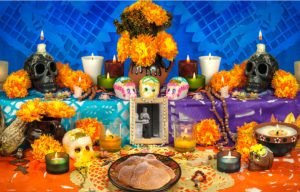Editor’s Note: Day of the Dead, or Día de los Muertos, is a traditional Mexican holiday celebrated November 2. On this day, it is believed that the souls of the dead return to visit their living family members. Many people celebrate this day by visiting the graves of deceased loved ones and setting up altars with their favorite foods, drink, and photos. The following is excerpted from a Chicago Tribune piece:
The Day of the Dead is bouquet and votive candles with an image of Our Lady of Guadalupe sit near the wedding portrait of Gardenia Rangel’s parents on a small table in the living room of their old home.
The electric candles haven’t been turned off since her mother and father both died of COVID-19 last February. Every so often, Rangel plays mariachi music to remember them.

They loved Mexican music, their daughter said.
“I think about them every single day,” Rangel said. “But I never want to stop missing them because they say that people only die the day you forget them.”
Rangel wants to find a way to celebrate her parents’ life this upcoming Day of The Dead by creating an ofrenda — an altar to honor the deceased — and planning a family gathering to share their legacy of love.
Hundreds of other Chicagoans lost to the coronavirus are also being remembered as part of Day of The Dead ofrendas throughout the region. Some families are setting up an altar for the first time, while others continue the Mexican tradition that is no longer solely folkloric, given the many deaths related to COVID-19.
According to tradition, it is believed that on the Day of the Dead, Nov. 2, families welcome back the souls of their deceased relatives to spend time with their loved ones, eat their favorite food, and have a celebration of life.
Since the earliest stages of Mexican culture, Mexicans have embraced death as a part of life. This acceptance of death has defined some modern Mexican rituals, such as “The Day of the Dead”, a celebration that honors those who are deceased. In celebration, many Mexicans decorate with skeletons that dance and play instruments.
Although other cultures may regard this as irreverent, it is not meant to trivialize the loss of a loved one, but rather affirm their belief in an afterlife — and ease grief.
Most Mexican Americans are Catholic and consider the funeral an important part of life. Services are heavily attended and lead by Catholic priests who honor the recently departed. In rural communities, the wake is usually held at the family’s home, where loved ones come to strengthen ties and pay respects to the deceased. In rural areas, the coffin is placed on a table or stand under burning candles and herbs. In an urban setting, the viewing will likely be held in a mortuary. The wake is followed by a church ceremony.
Attendees can expect:
- Strong emotional responses to be encouraged.
- Children who are socialized at a young age to accept death.
- A final ceremony to be held at the burial site.
- Relatives to throw a handful of dirt on the coffin before the grave is filled.
- Family members to bring candles to church and light them at the altar for nine days following the death.
Although Mexican Americans embrace death, it is important for them to say goodbye to loved ones with elaborate funerals and long periods of mourning.
CLICK HERE TO JOIN AFTERTALK
Free, Non-Profit and Non-denominational
Every Wednesday we will be publishing Pandemic Weekly for, we hope, not too long. We invite you to submit your thoughts, essays, poems or songs. Please send to info@aftertalk.com. To see past Pandemic Weeklies, CLICK HERE

